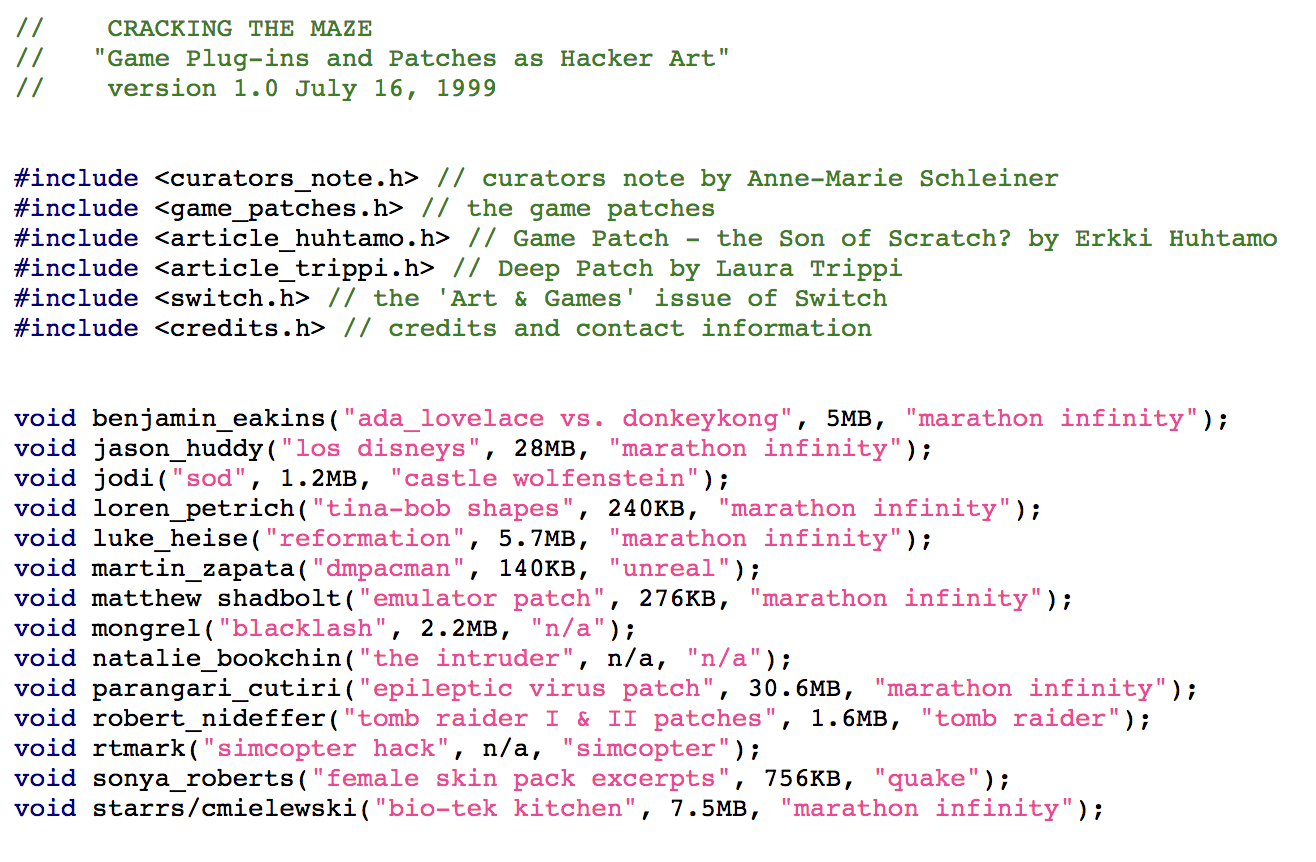Patches as Hacker Art
// As any avid gamer quickly discovers, the Internet is not only a free // source of computer game cheats and puzzle keys, but the home of // numerous game plug-ins and patches available for download. These // patches range from a simple repair of a programming bug to intricate // new game scenarios, replacing the characters, sounds, architecture // and/or game challenges in the original games. The increasing popularity // of these once unsanctioned game hacks has led some gaming companies, // like the producers of Quake and Marathon, to capitalize on the trend // and subsume this once renegade practice into their marketing strategy, // bundling patch-making software with their official games. Certainly the // Internet fame of the "Nude Raider" patch for Tomb Raider, a patch which // strips the protagonist Lara Croft�s already scanty attire to reveal // sharp nude polygons, is good PR for Tomb Raider. Web rumor has it that // Eidos Interactive faked and distributed the Nude Raider screenshots as // a publicity stunt. Another common application of game patches is in the // corporate Silicon Valley workspace, where workers relieve tension by // playing networked tunnel shooter games over their local ethernet // network, pasting photographs of themselves onto the games avatars and // customizing the architecture to mimic their own corporate habitat. // // Other game patches position themselves in a more critical and/or // subversive relation to their "hosts", the official game engines. Rather // than situating themselves as a hyperbole to the host game or as a // customized simulation, the more subversive patches offer alternatives // to the often rigidly defined genres of gameplay and sometimes create // new genres that are assimilated into the game marketplace. Although the // category of "feminist game patches" can be misleading, game patches // with female protagonists prefigure the first appearance of female // characters in official games like Tomb Raider, Resident Evil, and Final // Fantasy VII. The Marathon Infinity patch "Tina Shapes and Tina Sounds" // replaced the protagonist,"Infinity Bob" with a female Tina. A Japanese // Doom patch entitled "Otakon Doom" replaced the protagonist with a // Japanese animation girlfighter named "Priss". Still another Doom patch // replaced all the characters with the cast from the movie "Aliens", // including substituting Sigourney Weaver for the male protagonist. // Another variety of game patches humorously undermines the extremely // macho codes of interaction in shoot-em-up computer games by // substituting the standard adult male characters with androgynous // animals and goofy childrens fantasy characters. Take for instance the // Marathon patch that replaced all the characters with different colored // gumby dolls and the Doom patch entitled "Barney and his Minions". // // Although some artists have successfully created games as art, producing // a game patch as art offers certain advantages over building a game from // scratch. On a technical level, of course, the artist(s) avoids having // to put in the extensive time required for programming an interactive // game engine. But the parasitic game patch is also a means to infiltrate // gaming culture and to contribute to the formation of new configurations // of game characters, game space and gameplay. Like the sampling rap MC, // game hacker artists operate as culture hackers who manipulate existing // techno-semiotic structures towards different ends or, as described by // artist Brett Stalbaum, "who endeavor to get inside cultural systems and // make them do things they were never intended to do." "Cracking the // Maze" will exhibit both game patches created by artists and game patch // artifacts from the web produced by the original game hackers, in an // attempt to generate an open discourse on art, games, game hacking and // gaming culture on the Internet. // // Many artists, art critics, new media critics and theoreticians have // expressed a disdain for games and game style interactivity, in fact, to // describe an interactive computer art piece as "too game-like" is a // common pejorative. But considering the increasing popularity of // computer games with younger generations, even at the expense of // television, it seems perilous to ignore the spread of gaming culture. // What sorts of spaces computer games construct, what sorts of // gender-subject configurations operate in computer games, what sorts of // politics of 'the other' computer games employ, what modes of // interactivity and addiction computer games invite, how networked // on-line games construct alternate worlds, how gaming culture manifests // itself on the Internet--these are all areas ripe for investigation by // cultural critics and manipulation by game hacker artists. "Cracking the // Maze" will attempt to bring together discourse and activity in these // and other areas in relation to the game patch as hacker art. // // // // � Anne-Marie Schleiner 1998
































